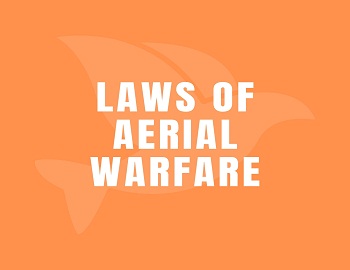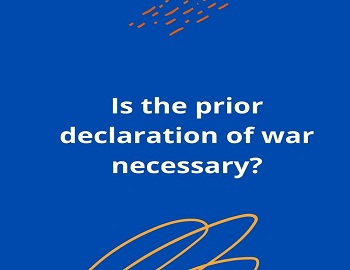Laws of Aerial Warfare:
Navigable air vessels were for the first time used in the First World War as an auxiliary arm for both land and naval operations, for a direct attack upon troops and ships, as well as for observing and surveying the enemy resource. “As the war progressed, its use was extended to cover operations outside the actual theatre of war. It was resorted to in this connection by belligerents on both sides not only with the object of attacking and destroying military objectives proper but also as a measure directed against the civilian population. In all the spheres, experience showed the need for an agreed regulation of this new weapon of warfare.
The rules of aerial warfare have been framed from time to time by different conventions. A brief study of these conventions follows-
(I) Brussels Conference- The conference was convened in 1874 by the Emperor of Russia to lay down rules on aerial warfare. The rules laid down that open or undefended town or villages were not to be attacked or bombarded.
But if a town or village was defended, it could be bombarded after due warning. It was also laid down that all necessary steps should be taken to spare, as far as possible, buildings devoted to religion, art, science and charity, hospitals and places where the sick and wounded were collected, on condition that they were not used at the same time for military purposes.
(II) The Hague Conference of 1899- The conference laid down that the bombardment of towns, villages, and dwellings that were undefended was prohibited. The Hague Convention of 1907 forbade the discharge of projectiles and explosives from balloons or by other similar new methods for a period of five years. The convention also imposed a duty on a neutral state to see that no fight in the air took place between the belligerents over its territory.
The institute adopted the principle in 1911, that “aerial war is allowed provided it does not present for the person or property of the peaceable population greater danger than land or sea warfare”.
(III) World War I (1914-18)- The rules of warfare had been ruthlessly violated in the First World War. The distinction between combatant and non-combatant had become almost non-existent in the eyes of those who were engaged in actual warfare. By the time the war came to its close, ruthless destruction of the civilian population, which actually fell outside military regions, became a common practice.
(IV) Washington Conference, 1922- With a view to regulate the use of aircraft against the armed forces, the maritime commerce and military objectives of the enemy and to protect the civilian population from the dangers of indiscriminate bombardment, the states, represented at the Washington Conference of 1922 on the Limitation of Armaments decided on the appointment of a commission of Jurists charged with the task of proposing code of Air Warfare Rules. In 1923, the commission produced the proposed code of rules. Although these have not been ratified, they are of importance, as an Authoritative attempt to clarify and formulate rules of law governing the use of aircraft in war, and they will doubtless prove a convenient starting point for any future step in this direction. On occasions government have announced, that they would act in accordance with the provisions of the Hague Air Warfare Rules.
The following are the most important rules of aerial warfare which were incorporated in the Air Warfare Rules, 1923-
(1) It is forbidden to arm a private aircraft even on grounds of self-defence.
(2) To coerce payment of many or any contribution, pressure should not be exerted by means of aerial bombardment.
(3) To bombard by air or to territories non-combatant civilian population is strictly prohibited. Private property of non-military character should not be destroyed.
(4) In order that aerial bombardment may be treated to be legitimate, it should be aimed at military objectives, the destruction of which would bring about a distinct military advantage to the belligerent. In other words, only military establishments, ammunition factories, lines of communication used for military purposes should be aimed to be destroyed by aerial bombardment.
(5) Destruction of such cities, towns or buildings as are not in close proximity of the operation of land forces is strictly prohibited.
(6) Areas in close proximity of the operations of the land forces may be bombarded only when there is sufficient and reasonable presumption that the concentration of military troops near the civil or non-combatant areas are important.
(7) Buildings meant for public worship, religion, art, science and charity as also historical monuments, hospitals, refugee shelters etc. should not be bombarded.
(8) Laws of war and neutrality applicable to land troops apply to aerial warfare as well.
(9) If any of the rules as mentioned above are violated by any of the belligerent’s officers or forces the belligerent state would be liable to compensate the loss sustained through such violations.
(V) The Geneva Protocol- The Geneva Protocol of 1925 forbade the use of gas and bacteria in warfare.
(VI) Disarmament Conference 1932- The Disarmament Conference resolved that air attacks on the civilian population shall be strictly prohibited.
(VII) The Second World War- The Second World War witnessed an utter disregard of the rules of aerial warfare. There was a complete violation of the rules by indiscriminate bombing of Warsaw and Polish cities in 1939 by German aircraft. The British and American air fleets also, in their turn, carried on an equally indiscriminate and ruthless bombing of German cities. The whole war was fought without any regard for the rules of warfare, non-combatants were mercilessly killed, and buildings devoted to public worship, art, religion and historical monuments were bombarded. At the climax of it all came the use of the atom bombs by the U.S.A. against Hiroshima and Nagasaki on August 6 and 9, 1945, without giving the warning of danger to the non-combatants and in defiance of the protests of many of the scientists, who had worked on the project. A few days later, on account of the devastation caused by the dropping of the atom bombs, Japan acknowledged her defeat, and thus the Second World War came to an end.
The use of atom bombs is a clear violation of International Laws since they are highly destructive, so their use should not be made. The United Nations Organization has been attempting to work out a plan for the peaceful use of atomic energy. It has been remarked that disarmament could also open up possibilities for joint international ventures of an ambitious kind such as the utilization of atomic energy for peaceful purposes, space research, exploration….for the benefit of mankind and projects to change the climate of large areas of the world. The future will tell the story of the success of the United Nations in this regard.









Comments (No)